A Month of Coronavirus: The Good, the Bad, and the Ugly
11 2020
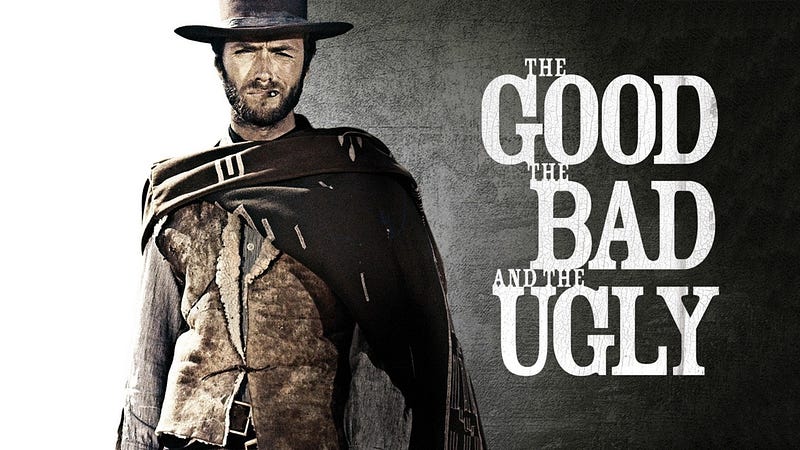
It’s overwhelming, isn’t it, this sudden change in American life? It’s been a month now, and it’s utterly thrown me off balance. I’ve been unable to put my thoughts together, and when I’ve tried to write I’ve often found my ideas out of date by the next day.
But as the number of cases in the United States has swelled to somewhere around 0.1% of the population, approximately the remaining 99.9% of us are suffering from hypochondria, fear, and panic about our health, our job security, or our family. This is partly because the corporate media has been on full-scale freak-out mode for the entire month, and while it is important to be informed, it isn’t healthy to be in the constant state of anxiety and fear the mainstream media channels apparently cannot resist instilling in us. So today I’m finally writing, from the perspective of the 99.9%.
There’s actually some very good news to discuss, as well as some bad news to more thoroughly understand, and there’s some other news, some troubling developments I’m calling “ugly.”
So here’s what I’m calling the Good, the Bad, and the Ugly about this whole pandemic, trying to put the good news and the bad news into perspective. Think of it as a summary of where we are today in this bizarre and hopefully short chapter in American history.
THE GOOD
Well, to start off, some really good news about this virus has emerged recently, if there can ever be “good news” about a virus. I’ve been tracking several streams of data for weeks, from a variety of sources, including raw numbers, projections about new cases and deaths, and news about transmission, treatments, and cures. All of it took a turn for the better this week.
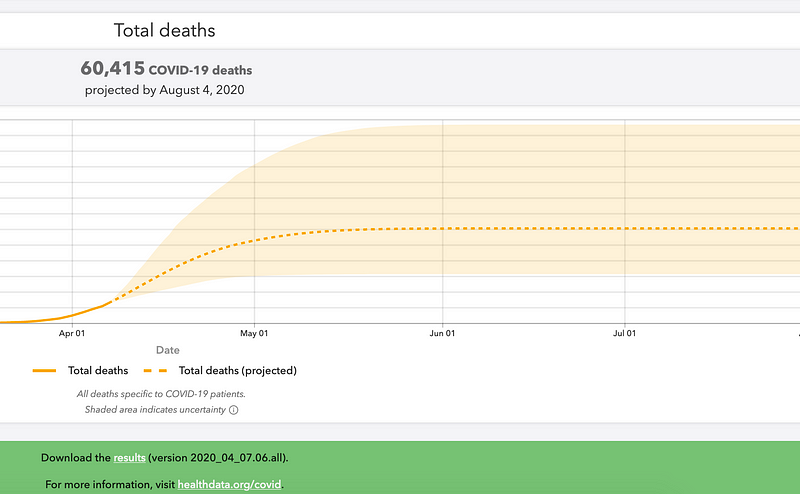
The Institute for Health Metrics (IHME) at the University of Washington — a well-respected organization creating complex modeling from all available data on the virus— has published daily projections for weeks. That data has swung recently in a very positive direction. They base their models on data from transmission rates, hospital resources, daily growth rates of cases, hospitalization rates, recovery rates, and more. While the numbers were beginning to look a little better throughout the first week of April, during this past week the projections have turned sharply better. Projected deaths for the entire country are now under 100,000, dropping to 80k, to 75k, and now to 60k.
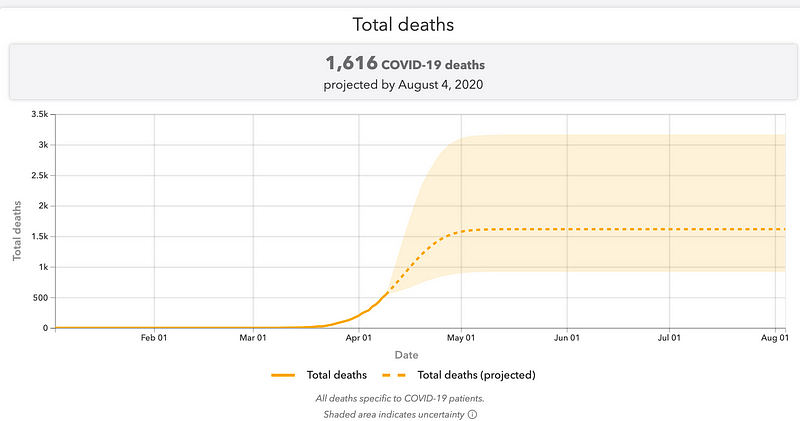
Projections for deaths in my state of California have dropped from 8,000 to 5,000 to 1,700 and now to 1,600. This is amazingly great news as we were recently told we could possibly expect tens of thousands of deaths. There is no longer any projected shortage of medical equipment in California (or in most states), which means the death rate will likely be well under 1% for those who contract the virus.
I said, “most states,” but not quite all states. New York is still in a rough spot, the worst in the country by far. But even there, the projected peak of this pandemic has now passed, as of this week, and the total projected death toll there has dropped from over 20,000, down to 15,000 and now to 13,000, which is far less than what was projected at the end of March. Hospital and ICU demand at the peak were also smaller than originally feared.
The fact that total deaths across the country are now projected to come in under 100,000 means that while this COVID-19 remains a big deal, it appears that we might be experiencing something about as deadly as a typical annual flu epidemic everywhere but New York and perhaps Massachusetts and New Jersey. In fact the number of deaths thus far this year from the flu, 23,000, outpaces the number of deaths thus far from COVID-19, 17,500.
For greater perspective, here are the annual deaths from leading causes in this country in a typical year, from the CDC:
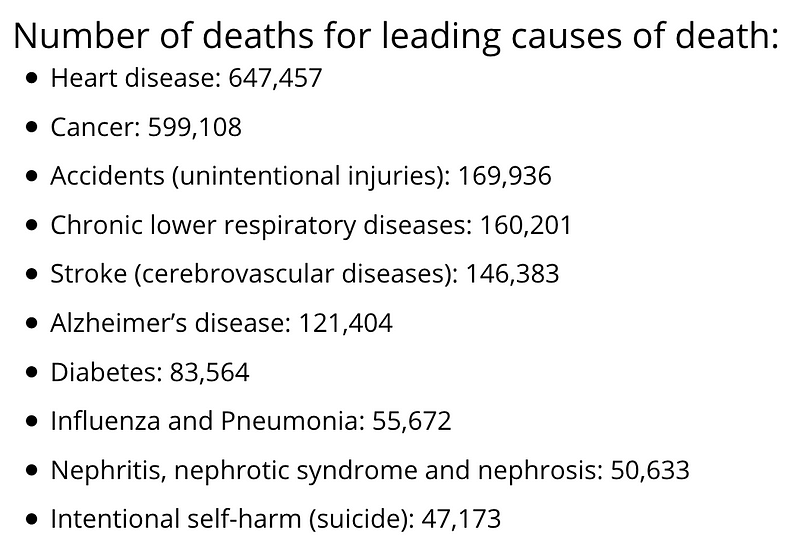
In addition to watching daily data from IHME and other sources, I’ve personally undertaken capturing and analyzing data for the state of California. I’ve been compiling this data here. If you peek at my data and charts, several of which I include below, the most important numbers are the growth rates of new cases and deaths, as these indicate people newly getting sick or dying. Total cases ever found becomes less important as people recover — that number becomes almost meaningless in gauging future needs and developments. Total number of deaths does matter of course, but it too is less important in understanding the severity of the situation than is following the growth rate in the number of deaths, as there are still only 600 deaths among the state’s population of 40 million, which wouldn’t put this virus in even the top twenty causes of death in the state.
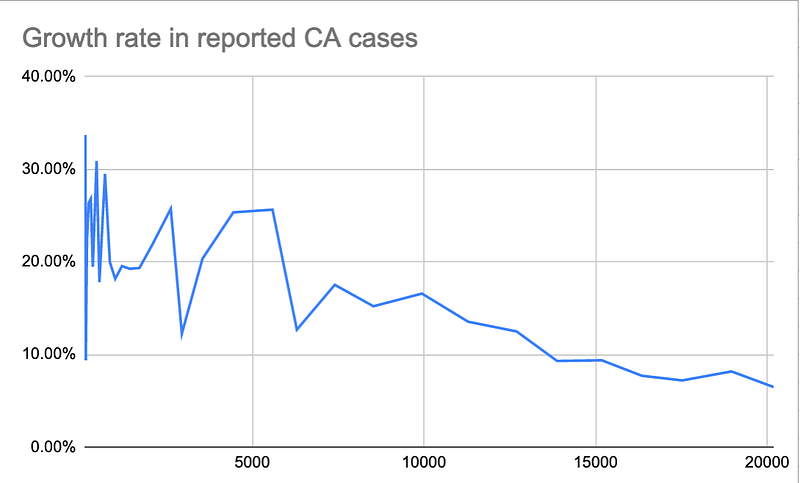
The charts demonstrate that these numbers are now trending sharply down, which is wonderful news. And if you understand math and the way exponential growth works, there’s a huge difference between growth rates of 25%, 20%, 15%, and 10% in terms of doubling. At 25% things get bad really fast. At 10% things are essentially under control. At 5% the epidemic is over because new cases are not coming in as fast as old cases are recovering and leaving the hospital. The drop from 20% to 15% was a strong positive change, and now the rates dropping below 10% is very, very promising indeed. Hopefully and probably this trend will continue.
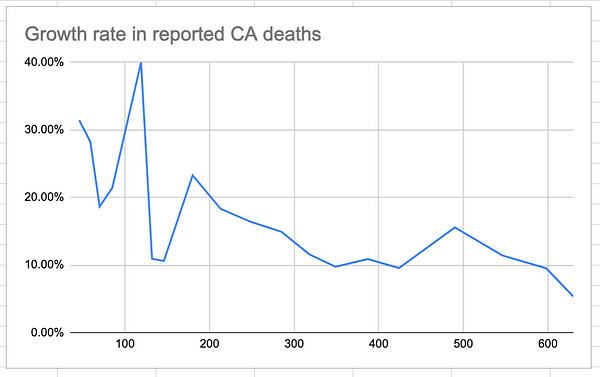
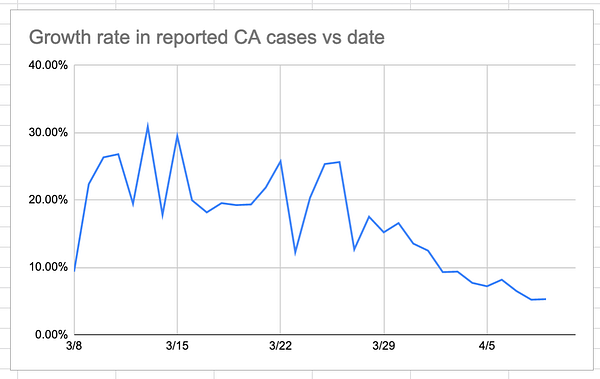
Perhaps the number of deaths will ultimately be higher or lower than current projections estimate, but they certainly will not be as high as the number of deaths from cancer or heart disease, and I don’t see us shutting down our economy on account of heart disease. For most of the month of March, I was of the belief that we as a country were doing too little to contain the virus, but at this point my view has changed.
As I see things now, despite the ongoing hysteria promoted in the corporate media every day, it’s not worth it to further destroy our national economy or further diminish our privacy or physical liberties. The state of our economy and civil liberties were already poor in this era of growing wealth inequality and increasing government surveillance, and we must be very careful in letting these get any worse. I’m not advocating that all “shelter-in-place” restrictions be lifted today — social distancing likely has helped. But it’s also probably true that the transmission rates and the death rates have been exaggerated. We must begin to lift these draconian restrictions on our culture, economy, and lifestyle at some point soon — later this month or in early May, I would say, barring a massive reversal in the trends. We’re already on a crash course with a Great Depression, which would be ridiculously more destructive than a virus that takes out 0.02% of the population. There have always been viruses; there have been many very bad viruses; a flu outbreak in 1957 took out over 100,000 Americans at a time when our population was much smaller, but the country didn’t shut down then and that virus didn’t destroy us.
On the other hand, it is worth it to immediately pass Medicare for All, Paid Sick Leave, and a Jobs Guarantee. How unbelievable it is — how utterly shameful — that all these people losing their jobs will just have to go without healthcare in the midst of this pandemic. And we call this civilization? Here in the second week of April we’re seeing millions of people losing their jobs daily and being kicked off the rolls of these greedy health insurance corporations. No citizen of any other country in the developed world is losing healthcare in this virus-induced recession, and that’s because healthcare everywhere else is considered an essential component of a just society. A piece of good news is that the American people increasingly recognize this; we as a people do want to ensure everyone gets care when they’re sick, even if they’re poor, and passing Medicare for All remains popular even if neither party will yet confront their corporate donors and push for it, but it now seems only a matter of time. This is good, and it can’t come too soon.
As for the ongoing scientific discoveries around transmission rates and cures for this virus, my expertise is too limited to comment in depth. There remains no scientific consensus on transmission, which is maddening. As the country plunges into one giant shared OCD complex, we don’t have conclusive knowledge whether the virus is transmitted by large droplets, small droplets, or aerosolized particles; whether it lives on surfaces and if so for how long; whether masks are helpful, and if so which ones. There is evidence both that the virus lives for days on surfaces and that the virus can’t survive at all on surfaces. As for cures, there is encouraging news and reasons to be optimistic about hydroxychloroquine, ivermectin, and intravenous vitamin c; these and other possibilities should be thoroughly and publicly researched. Surely there will be an expensive proprietary pharmaceutical product developed for the rich, which is good news too, but for everyone without sufficient funds to satisfy Big Pharma, inexpensive possibilities must be vigorously explored by nonprofit entities, and we can and should insist that all cures and vaccines developed with government money are free for patients.
THE BAD
That’s the good news. There’s abundant evidence that most of the country is nearing the peak of this crisis and that the pandemic won’t be as bad as many feared. Nevertheless, there are still many people getting sick, suffering, and dying, particularly in New York, New Jersey, Connecticut, and Massachusetts. The death rates in these states are above the typical death toll of a normal year of the flu, and in some cases medical facilities are being overrun, although this situation will improve as other states continue to dispatch equipment and personnel. While I expect the numbers quoted above to prove roughly correct—the IHME has been overly pessimistic in their projections thus far and has revised most numbers downward—but if that data proves too optimistic, we could see the death rates in these impacted areas and others exceed current projections.
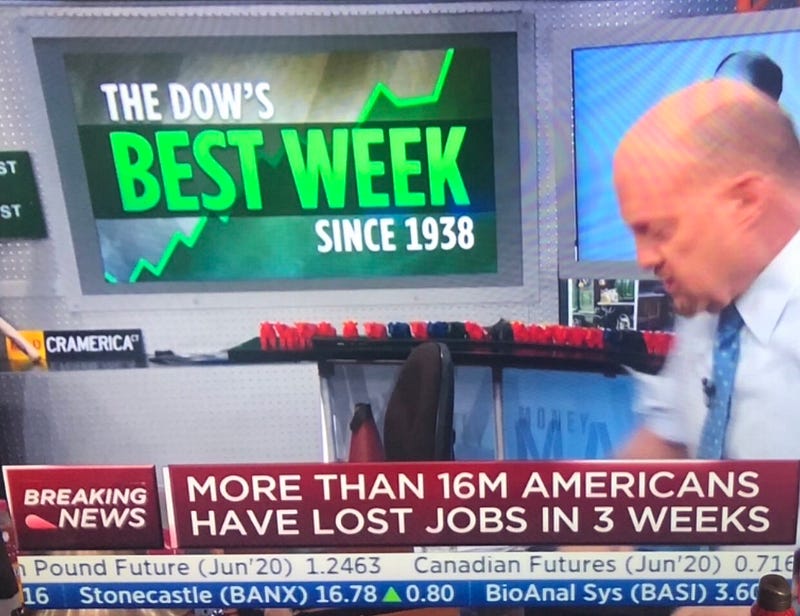
What’s far worse, and really the main piece of bad news, is that the economy for everyday working people really is tanking. Millions upon millions are facing layoffs, wage cuts, and unemployment. Seventeen million people have already filed jobless claims, and the unemployment rate is skyrocketing. Globally, a new study reveals half a billion more people could be pushed into poverty if heavy coronavirus restrictions on business continue.
In this country, the government policies enacted ostensibly to help everyday people avoid the virus have already destroyed some 10% of all jobs, and as mentioned above we still have not implemented a Medicare for All plan despite the screaming immediate need for it. Thus millions of people will lose their health insurance along with their jobs. No, during a pandemic, this “system” of ours that conservatives in both parties defend does not “let you keep your healthcare.” You can’t keep your plan if your employer chooses to change it — or chooses to lay you off. Your healthcare is a conditional perk of employment. And no, you can’t just “open the Obamacare exchanges” because unemployed people don’t have money for those plans. And no, health insurance and hospital corporations aren’t thinking of your health right now; they’re caring for their profits. It is past time to nationalize healthcare, drugs, and vaccines and to remove the profit motive from how we choose to care for — or, currently, not care for—the people who get sick in this country. But we don’t have Medicare for All yet, and the profit-driven pharmaceuticals, hospitals, and health insurers will use the corrupt campaign finance system to ensure that all approved testing, cures, and vaccines for COVID-19 are chosen and accelerated or decelerated depending on who gets the profit.
The congressional “CARES Act” bailout has been a massive disappointment at a time when something truly groundbreaking was both possible and necessary. As the hosts in this Rising video explain, the bill that was passed will bailout corporations while leaving millions hopeless and hungry. The one-time cash payment of $1200 that will arrive in May or June (or later for those who haven’t set up direct deposit with the IRS) is laughably, insultingly small, and many people won’t even receive it at all. Bernie Sanders proposed regular monthly payments of $2,000 that would start immediately and go to everyone — that would have been significant. Or why not just give the $4 trillion straight to the 127 million American households in one-time cash payments of $31,000?
Fortunately, although Sanders has not been placed in the position of leadership where the country so badly needs him, he did fight tooth-and-nail to wedge a massive expansion of unemployment benefits into the bill, to the tune of $600 per week on top of any benefits people already had. This is the kind of thing Sanders has done throughout his career — work inside conservative-controlled legislatures to attach very significant amendments to otherwise troubling bills — and it will be a godsend to many newly unemployed folks trying to keep eating and paying rent.
That brings us to this primary, and what it has revealed about the Democratic Party. Sanders called in mid-March for the remaining elections to be postponed due to the pandemic, but Joe Biden and the Democratic National Committee (DNC) demanded the primaries continue — likely because they saw Biden’s edge in momentum and the depressed turnout as a chance to finally run Sanders out of the race, something they’ve long desired. They threatened penalties on state parties that delayed their primaries. Most states delayed their elections anyway, but Florida, Arizona, Illinois and others heeded the wishes of the DNC and held their elections, virus be damned, and now many poll workers in these states have contracted this virus. In the lead up to the Wisconsin primary last week, Joe Biden and the DNC were still demanding the primary go forward. But after Wisconsin, the very moment Bernie left the race, the DNC and their friends in the corporate media changed their tune and began crying foul that the Wisconsin primary had not been postponed; they began blaming it on the GOP and claiming that it is Trump and the GOP who are to blame for not responding to the virus sooner. Tom Perez and the DNC were strangely saying nothing of the kind while forcing states to hold primaries. Yes, this is the other big part of the bad news: The DNC is so obviously corrupt that they chose to expose voters and poll workers to this deadly virus in order to clinch victory for their weak establishment candidate and defeat the populist who wants to bring sweeping change to the economy and change in some small way the way they, the DNC, run things.
So Sanders is now out of the race. The media will say, “Bernie lost because his ideas were too radical.” But can anyone really say now that Bernie’s ideas are too radical? Healthcare for all, a living wage for workers, rent control, paid sick leave, forgiving student debt. These proposals are the minimum to deal with this crisis and restore a decent economy to this country.
There is a lingering question as to whether Biden has won the primary fair and square. For now, I can’t say with certainty. We know the DNC rigged the Iowa Caucus against Sanders, we know the DNC orchestrated a series of major events in the hours before Super Tuesday to help Biden and hurt Sanders, we know there was massive voter suppression on Super Tuesday in college towns and Latino-heavy areas in many states, and as principled law professor and congressional candidate Tim Canova explains there is a prima facie case that manipulated software in the voting machines further rigged the votes. I’ll be looking more closely at all of this in a future piece.
Whether legitimate or not, as I wrote back in January, a Biden candidacy has at best a 20% chance of defeating Trump, and with new, credible rape allegations against Biden and his mental decline, I don’t know if he has even that chance now. Biden is the polar opposite of a candidate who inspires independents to vote, and that essentially closes off his path to the electoral college in 2020.
So that’s the bad news — an economy in swift decline and the evaporation of progressive populist opposition to the mismanagement of that declining economy. It isn’t a pretty picture.
The Ugly
The nation’s economy is sinking deep and sinking fast, and the DNC is too corrupt to provide any real opposition to Donald Trump. But what’s worse than bad — what’s truly ugly— are the attempts by corrupt elements of our government and corporations to take advantage of an anxious and trusting public to seize power during this crisis for their own ends.
“Never let a good crisis go to waste,” goes the famous political adage, first evidently used by Winston Churchill. These words surely apply in these strange times. We must be vigilant and watch what extraordinary powers both benign and cynical government officials may try to take during this crisis.
“Never let a good crisis go to waste” — Winston Churchill
We’ve already witnessed in these past few weeks ugly moves towards authoritarianism: expanding news censorship, hints of martial law, and whispers of forced medical procedures. Let’s look briefly at each of these developments.
1. News Censorship
I had planned to open this article with a link to two popular articles on COVID-19, one taking an extremely alarmist position on the virus and another taking a more patient view. Many unknowns remain about this virus — its transmission rates, death rates, and origin — and I thought it would be interesting to compare and contrast the two articles.
The problem is, the one taking the more careful view was taken down by Medium about a day after it was published. The piece advocating the more extreme approach remains up and has continued to attract thousands of views.
And it hasn’t ended there. Our once-free realm of information is disappearing. I’ve written at length about the need for a balanced media diet because the corporate media is biased, dishonest, and corrupt more often than not. For several years now, corporate media pundits have called everything that doesn’t fit their narrative “fake news” and demanded it be censored; they’re apparently getting their way today. Many articles and videos with a more measured take on the virus have been deleted, hidden, or censored by Medium, Twitter, Facebook, YouTube, and Google — and in such similar fashion it appears be a coordinated effort, perhaps based on a meeting tech giants had with the WHO. Censorship is always at best a clumsy way to guide conversation and at worst a bad-faith authoritarian attempt to force one interpretation of events. It is critical in a democracy — and for any semblance of community — that different views be voiced and considered.
I am still able to provide both of these popular articles for you. Although neither author has medical credentials nor epidemiological expertise, both write well enough and handle statistics relatively competently. Ginn is a writer and founder of a conservative-leaning think tank; Pueyo is a successful marketing consultant specializing in viral business apps. I think they both remain important reading and find it alarming that one would be censored.
- COVID-19: Evidence Over Hysteria by Aaron Ginn
A view of this virus from a more patient angle.
Note: Since this article is censored on Medium, the above link goes to a version republished on ZeroHedge that isn’t properly formatted and is wrapped in negative tweets and disclaimers. Apologies. I find that it is still readable. - Coronavirus: The Hammer and the Dance by Tomas Pueyo
A view of this virus from a more alarmist angle.
2. Hints of martial law
While many preventative measures, such as shelter-in-place directives, do seem justified for now, utilizing the police or military to force people off the roads or into mandatory quarantine is not. It is important to contemplate this difference and to be aware of government and corporate overreach in times of crisis.
- Rhode Island Governor Gina Raimondo deployed State Police troopers and the National Guard to the state border to stop passenger vehicles with New York plates. She ordered anyone traveling from New York to self-quarantine for 14 days upon arrival.
- Florida Governor Ron DeSantis declared that drivers entering the state from New York or Louisiana must self-quarantine or face jail time in a proclamation effectively criminalizing carrying the virus while traveling in the state.
“Those who would give up essential liberty for a little temporary safety deserve neither liberty nor safety.”
— Benjamin Franklin
- Apple and Google are (for perhaps the first time) cooperating to deliver surveillance “upgrades” to your phone so that a new app will operate behind the scenes tracking whether or not you’ve come into contact with someone who has the virus. It is presented as “opt-in” software, but the “opt-in” is apparently about turning it on, not installing it in the first place. From one perspective it sounds innocent, but a cross-platform monitoring app installed on everyone’s phone at once without their choice is also a totalitarian government’s fantasy. Imagine a world where any person’s whereabouts is known at a glance, and “good people” rat out “bad people” by labeling the status of all who they have come into contact with.
3. Talk of forced medical operations, forced testing, forced vaccines
- Of the countless ugly recent corporate media moments this one was shudder-worthy enough George Orwell may have turned over in his grave. Rachel Maddow interviewed New York Times guy Dan McNeil and shared with her innocent but anxious viewers a vision of a regime in this country which forcibly and repeatedly tests everyone for this virus and in which parents are forcibly abducted from their homes if they test positive. Maddow deserves little trust after her wholesale “drinking of the kool-aid” on Russiagate, and yet her show is still watched by many wealthier, Democrat-leaning liberals and for that reason remains in my balanced media diet. Rather than question the horrifying ramifications of forcing people to undergo tests, invading homes, and splitting up families like this, she eggs McNeil on as he declares that even people with minor symptoms should be removed from their homes and forced into isolation camps. May it never come to this.
- Bill Gates regularly appears on corporate media and is always presented as a disinterested and intelligent philanthropist working for the betterment of society. What isn’t mentioned is that he always happens to be the person most forcefully advocating the heaviest of quarantine laws and the most draconian of vaccine requirements. It turns out he has some worrisome conflicts of interest that should give us pause before surrendering basic freedoms based on his opinions.
- England’s The Telegraph reported that Germany will issue coronavirus “antibody certificates” to enable quarantined people to re-enter society. While this might truly be a benign attempt to get people back to work, the ramifications could force those who don’t “have their papers” into quarantine. We should share a common goal: This virus must be contained and be viewed ultimately like another flu, as something for which a few days or weeks of rest is highly recommended — and rarely hospitalization — but not as something powerful people can use to determine who is eligible to participate in society and who is sent away to quarantine.
The last time national hysteria was at this level — in the wake of 9–11 — some of the most corrupt elements of our government seized unprecedented powers of surveillance, violated the privacy of millions, and launched illegal wars they’d been planning for years. Much of the Patriot Act was in fact written long before 9–11, in bills authored by Joe Biden that were then rushed through Congress under the “never let a good crisis go to waste” mindset.
Sharp independent columnist Caitlin Johnstone sounds the alarm in this short piece. “Enormous changes are happening right now, and powerful people are conspiring to advance their own interests as this unfolds…”
Signs of martial law, news censorship and propaganda, and talk of forced medical procedures are ugly developments that we should monitor closely. We need to tend to this virus wisely and contain it, we must safeguard the underlying structure of this economy and preserve it, and we must be vigilant so as not to sacrifice, as Benjamin Franklin put it, “essential liberty for a little temporary safety.”
THE IMMEDIATE FUTURE
Yes, there is good news and bad news, as always. This virus is apparently less dangerous and less deadly than many originally thought. The economy is spiraling downward and broader poverty is on the horizon. And we have an increasingly corrupt two-party system featuring dishonest oligarchs and lifetime politicians who possibly seek to utilize this crisis to increase their power.
That’s where we are. That’s the Good, the Bad, and the Ugly. That’s a month of the coronavirus. So where does that leave us today, what does that mean for the next month? Will our future get better, worse, uglier?
Predictions are notoriously difficult — and often embarrassing in retrospect — but I’ve been right about a few things recently so I feel up to taking a chance. I’m hedging my bets by giving three predictions, three potential futures, and I assign each of them a likelihood. Here are a best case scenario, a sort of middling depressing scenario, and a disastrous worst case scenario.
BEST CASE SCENARIO
(Likelihood: 65%)
- All states have hit their peak hospital and ICU resource usage by the end of this month.
- The death toll nationally stays below 0.05%, which would be 170,000 people, roughly equivalent to the death count from the 1957 flu epidemic. Perhaps it even stays below 100,000. The current projection is 60,000.
- Businesses reopen in a staged fashion throughout the month of May.
- The economic downturn is largely temporary, and a Great Depression is averted.
- We look back around Halloween and realize this coronavirus was about as deadly as a bad year of the flu, perhaps not as bad as the 1957 epidemic.
- The country seriously debates — and perhaps even finally passes — Medicare for All as well as a Jobs Guarantee and Sick Leave, so that we’re prepared for any recurrence of this virus or another.
MEDIOCRE SCENARIO
(Likelihood: 25%)
- Some states see strong second waves of the virus emerge in May and June, creating New York-like spikes in cases and deaths, overwhelming medical resources.
- The death count surpasses 170,000, the 0.05% rate of the 1957 epidemic.
- Shelter-in-place restrictions and lockdowns are maintained through May, through June, and even into July, August, and September in some places.
- The economic downturn deepens. Many businesses permanently close and millions are suddenly unemployed in a deepening recession.
- The virus gradually recedes but businesses aren’t allowed to fully open until September and October, and many by that time have gone under.
- A Second Great Depression is the true and lasting impact of the virus.
WORST CASE SCENARIO
(Likelihood: 10%)
- The Second Great Depression is worse than the first. Millions are out of work; unemployment spikes above 35%; most small and medium-sized businesses fail. A few giant corporations run the country’s economy.
- Lines at grocery stores. Not enough food, sanitary supplies, or healthcare for people. Everyone seems to be getting ill.
- Martial law. Reduced freedom of movement. Checkpoints on highways.
- Increased censorship of the news. The term “fake news” is used to stifle all dissent. This article and all like it are scrubbed from social media, YouTube, and Google.
- Forced vaccines and repeated testing. Forced quarantine. Forced separation from friends and family who test positive.
- Cash prohibited, ostensibly as protection from the virus, outlawing all financial activity the government cannot control.
- Increased surveillance. Publishing via every phone in real time the whereabouts of anyone who hasn’t been tested or vaccinated.
OK, I ended on a real doomsday note there, but it’s not impossible. If you’ve read 1984 or Fahrenheit 451 or Anthem or any of the dystopian books on totalitarianism, you know that the technologies from those books essentially all now exist. What we don’t have thankfully is the political situation of those books, and we must keep it that way. We do have a corrupt and opportunistic government, and we must be aware that, as always, power corrupts and absolute technological power like that enabled by the latest gadgets corrupts absolutely. Vigilance remains the price of freedom.
The virus is bad; the economic downturn will probably be worse; a political slide towards martial law would be the most horrible outcome of all. I do believe I’m being alarmist here, but not without some grounds for concern.
I give that doomsday Worst Case Scenario only a 10% likelihood of occurrence, but it’s possible we could have a mixed future, with some components of each scenario.
The Best Case Scenario has a 65% likelihood of occurrence in my opinion, and I do believe that most likely the peak of the virus has passes or is just around the corner, businesses will be able to reopen in May, this article will not be censored, and I’ll look back on my doomsday visions in this section with mild embarrassment.
For those who are confused or upset by my concern about forced vaccinations and medical procedures, it is because there are whispers about this from powerful people like Bill Gates and unquestioning reports in the corporate media. Please consider the sordid past of all government-forced medical procedures and government-forced physical choices. If you’ve studied politics or history with any depth you surely know that there is simply no committee or bureaucrat or sage or scientist or university of elders that knows enough — and is honest enough — to be entrusted with dictating what a whole nation of human beings can do with their own bodies. Indeed it is the very foundation of liberty to be in control of one’s own physical being, and it is the fundamental basis of punishment to deprive one of this liberty. Whether it’s instances of dictating what one must do or dictating what one must not do, the forcible requirement is always presented as “for the good of society,” but every requirement of this type is unjust and its promulgation always goes badly. To understand this, consider the forced sterilizations, lobotomies, and plutonium injections that happened in the last century, or contemplate the prohibitions on what we can do with our bodies, such as anti-abortion and sodomy laws that still exist in some places.
By all means, this government and the corporations that essentially control it should create great cures or vaccines for us, and if they’re effective and safe they should get to watch as people line up to request these products or operations, but no physical bodily choice should ever be forced or forcibly prohibited. This law transcends nations. Your body, your choice.
Personally, this past month has been a difficult time to write. It hasn’t been easy delving in and processing all of the data and projections, all of the hysteria, illness, fear, and corruption. But I also long to share that there have been silver linings in this cloud for me, and I hope there have been for you as well. I’ve been spending much more time at home with my family, and this slowing down has brought many small joys in cooking, reading broadly, playing with my son, relaxing with my wife.
Your experience right now might be similar to mine or entirely different. What is profound is the fact that we’re all going through it together, at once; this may just bear unexpected fruits of awakening and shared consciousness in the days and years to come.
For now, I wish that this moment and this strange chapter in history finds you and your loved ones well, or at least well enough to reach out to each other.
If you disagree with a conclusion I’ve drawn or notice something I’ve missed, please feel free to reach out. And even more — if you see things similarly to the way I have laid them out here, please reach out and let me know. It is helpful to know that there are kindred souls all around us. Let me know you’re there. We need all the friends and allies we can find in this uncommon time; it is a season that is incalculably full of the good, the bad, the ugly, and the beautiful.


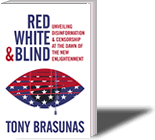

Connect & Share